Guest post by Anita Viola Sganzerla, Curator
Angelica Kauffman RA (1741–1807) was one of the most distinguished and successful women artists of her time. Educated, talented, sophisticated, attractive, she charmed the art world, fellow artists, and patrons alike. From London to Rome, patrons queued to be immortalized in her characteristic portraits in all’antica attire that succeeded in lending her illustrious sitters the allure of the past. Her works were widely reproduced in print, as well as copied and adapted for the decoration of porcelain and fans. Her success was such that, in 1781, the Danish ambassador in London quoted an engraver as having said, “the whole world is Angelicamad.”
A large exhibition devoted to her at the Museum Kunstpalast in Düsseldorf in the summer of 2020, and the accompanying catalogue, offered a unique opportunity to recognize Kauffman’s achievements and her place within art history.

My personal interest in Kauffman is connected to the history of self-portraiture and depictions of artists at work, with special focus on women. Hers is a fascinating case study because of her highly personal engagement with the genre, and the unique blend of history and allegory found in her portraits.
Angelica Kauffman in Düsseldorf: A Worthy Celebration
Curated by the eminent Kauffman expert Bettina Baumgärtel (Head of the painting collection of the Museum Kunstpalast, and responsible for the Angelika Kauffman Research Project), the Düsseldorf exhibition featured a selection of 110 among her finest works, including masterpieces and paintings of recent identification.
Sadly, the show’s much anticipated second leg at the Royal Academy of Art was cancelled—as so many were last year—leaving the London institution still waiting for a celebration of one of its only two female founders.
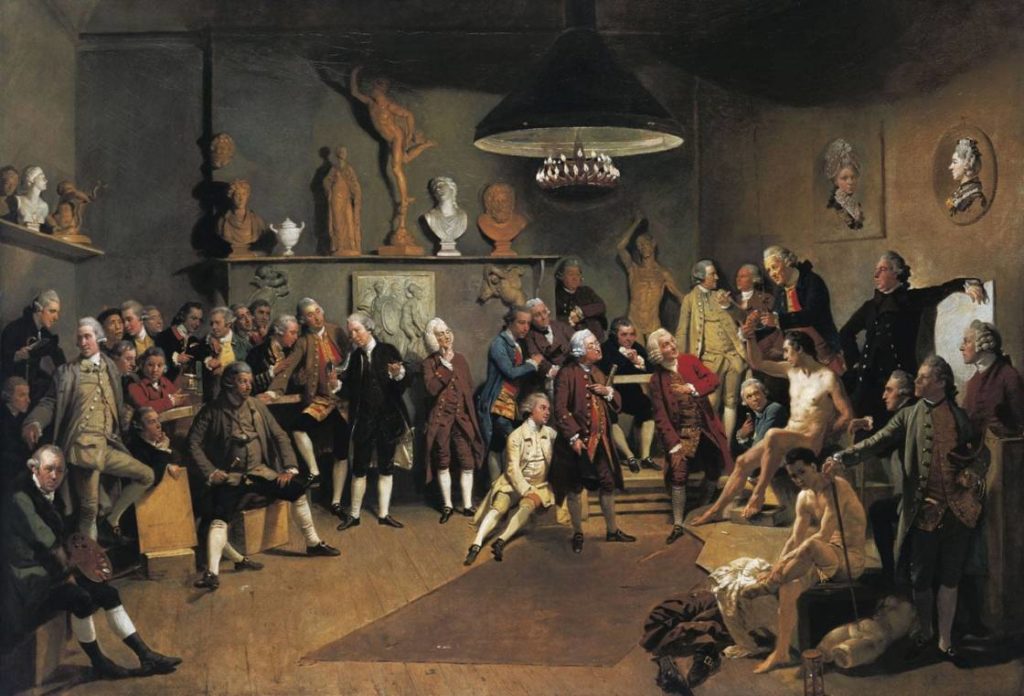
Johann Jacob Zoffany’s group portrait of the founding members of the Royal Academy is well known. It includes the bust-length portraits of Kauffman and Mary Moser (1744–1819), hanging on the wall at far right, as their presence in the life-drawing classes would have been deemed improper. Indeed, women’s training was greatly restricted by the lack of in-depth knowledge of the workings of the male body, the essential component of narrative history painting, long regarded as the noblest of art genres. Not that this was to stop Kauffman from achieving her expressive ambitions.
One of the highlights of the Museum Kunstpalast display was the presentation of the four ceiling paintings Kauffman created for the Royal Academy’s Council Room in Somerset House. These works illustrate the elements of art: Invention, Composition, Design and Colour. Presented outside London for the first time since their unveiling in 1780, the oval paintings are exceptional as major decorative works entirely executed by a woman. That he entrusted the project to her is a mark of the high esteem in which Joshua Reynolds (1723–1792), the Royal Academy’s first President, held the artist.
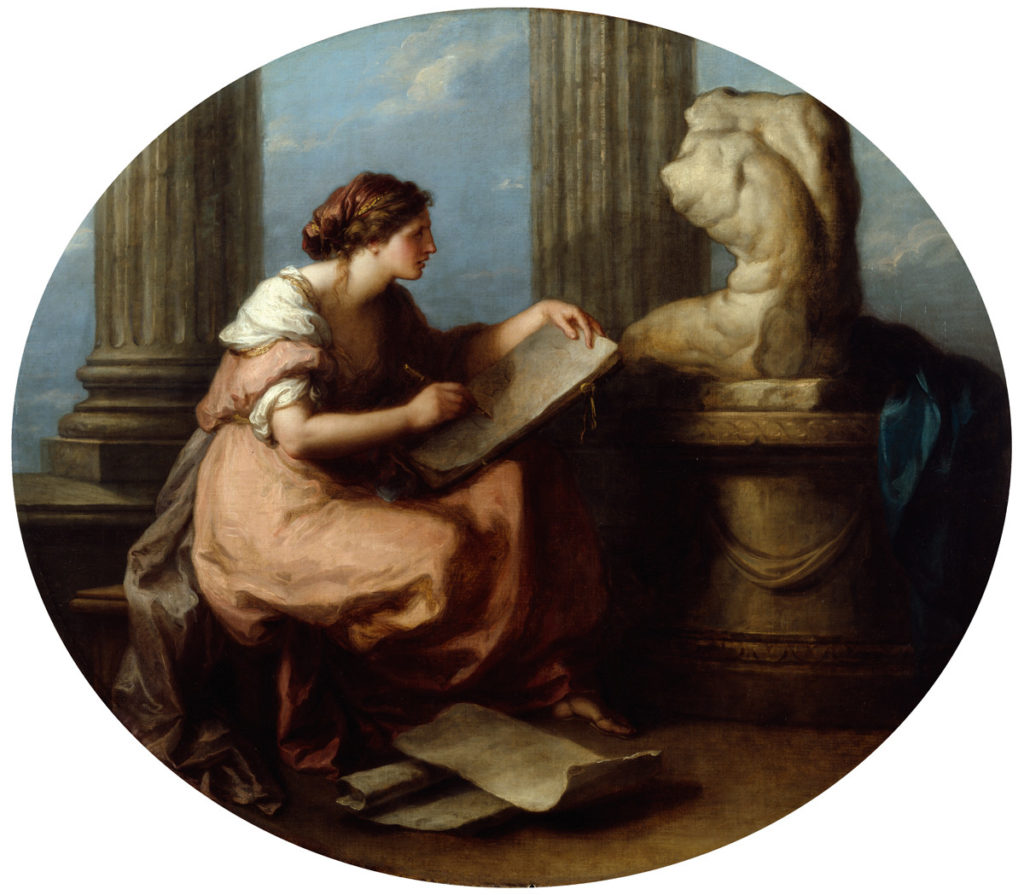
The four female allegories are more than mere symbols of the arts they represent: Kauffman designs them as alter-egos of herself and her fellow women artists. Particularly notable is her depiction of Design (in Italian, Disegno), traditionally a male personification, shown as a woman artist intent in studying a famous antique model (the Belvedere Torso). The allegories’ all’antica attires are typical of Kauffman’s portrait style and contribute to lending the figures the authority of historical characters.
The careful preparation of the panels involved the execution of four monochrome oil sketches, now held at the Victoria and Albert Museum, which visitors to the Düsseldorf show were able to see alongside the finished ceiling decorations. The preparatory sketch for Colouring, for instance, includes a chameleon, an original and witty association signifying the variety of colours found in nature.


Fig. 5. Angelica Kauffman, Colouring, 1778–80, oil sketch in grisaille, 22.4 x 28 cm, horizontal oval, Victoria and Albert Museum, London.
The Museum Kunstpalast exhibition’s careful selection of works covered the full span of Kauffman’s career, tracing the path that from her early beginnings brought her to London and further.
The Artist and Her Image
Born in Chur, Switzerland, Kauffman spent her early childhood in Valtellina in northern Lombardy. From 1752 to 1766 she received her education and artistic training in both Vorarlberg and Italy. She studied painting with her father, and singing and languages with her mother. She demonstrated early promise in both disciplines as eloquently, and touchingly, expressed in her Self-portrait as a Singer with Sheet Music, made when she was only twelve years old. This self-affirming image, a striking statement of female agency in the arts, brings to mind similar images of the young Mozart. Indeed, Kauffman was herself a child prodigy: her father paraded her around the northern Italian princely courts to showcase her skills as a singer and clavichord player.

Here, in her earliest self-portrait—a genre she would cultivate throughout her career—Kauffman employed her painting skills to celebrate her double talents as a painter and singer. Things were to change drastically for the young Angelica with the death of her mother in Milan in 1757, after which she decided to devote herself solely to painting.
As a painter, she spent her formative years in Italy, where she befriended, and portrayed, the likes of Johann Joachim Winckelmann (1717–1768) and Giovanni Battista Piranesi (1720–1778). After her fruitful years in London, in the latter part of her life she settled in Rome, where she set up a successful studio.
The Sister Arts
The self-portrait with sheet music is interesting as a precursor of more mature reflections on the relationship between the visual and liberal arts. Her Self-Portrait in the Character of Design Listening to the Inspiration of Poetry shows Design following the guidance of Poetry so as to create persuasive inventions and earn her place amongst the liberal arts.

Her meditation on the amity between the arts, and the pursuit of fame, culminates in the Self-portrait at the Crossroads between the Arts of Music and Painting, made in Rome. By then in her 50s, Kauffman revisited the hard choice she had faced as a young woman.
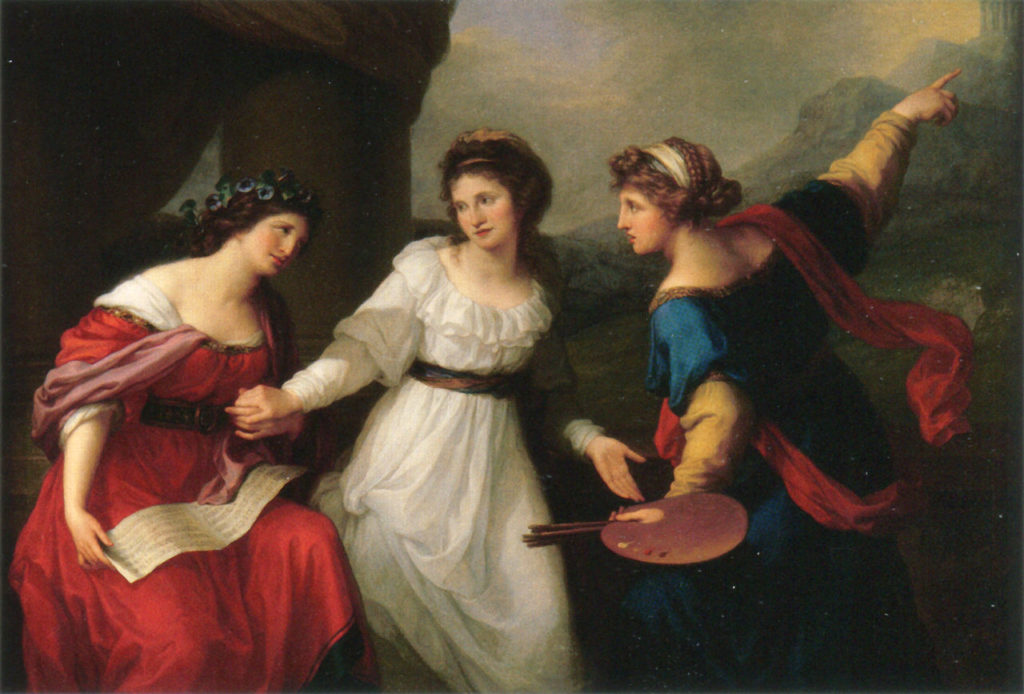
This painting is quintessentially Kauffman, with its blend of portraiture and history. It is also a personal reinterpretation of the famous subject of Hercules at the Crossroads, where the mighty hero is presented with the choice between virtue and vice. In Annibale Carracci’s version of it, Virtue directs Hercules towards the steep and winding road that leads one to glory. Similarly, in Kauffman’s work, Painting, gestures upwards towards the temple of Fame that sits high on a hill-top.

In contrast to the mythological tale, there is nothing lascivious about Kauffman’s other companion, Music, who sits to her right holding her hand as if in a final plea. By presenting the choice between her two inclinations as at once amicable and difficult, Kauffman stresses the absence of a real rivalry between the arts, which she sees united by a bond of sisterhood. To her, choosing painting means choosing freedom and independence, away from the constraints of courtly life that music would have tied her to.
Moreover, by evoking the theme of the Three Graces, Kauffman embraces her contemporaries’ celebration of herself as the “paintress of the Graces,” by virtue of the beauty and poise of her figures. These qualities, to her, were inextricably linked to her subjects’ nobility of character.
It is no coincidence that in her portrait of Johann Joachim Winckelmann, made three decades earlier, she had shown the great scholar and antiquarian intent in meditating over the subject of the Three Graces, fundamental to his precepts on the ideal of beauty. Alongside her self-portraits, Kauffman’s representations of exemplary women, both historical and contemporary, show her enduring debt to Winckelmann’s principles.

Female Heroines
Amongst Kauffman’s many depictions of episodes from ancient history where she re-cast women as the main protagonists, I find her images of mourning particularly striking.
The nocturnal scene of Cleopatra Adorning the Tomb of Mark Antony, exhibited at the Royal Academy in 1770, is an early example of Kauffman’s novel approach to history painting. By focusing on Cleopatra’s grief over the loss of her lover, she turns her into a positive and relatable example, especially to a female audience.
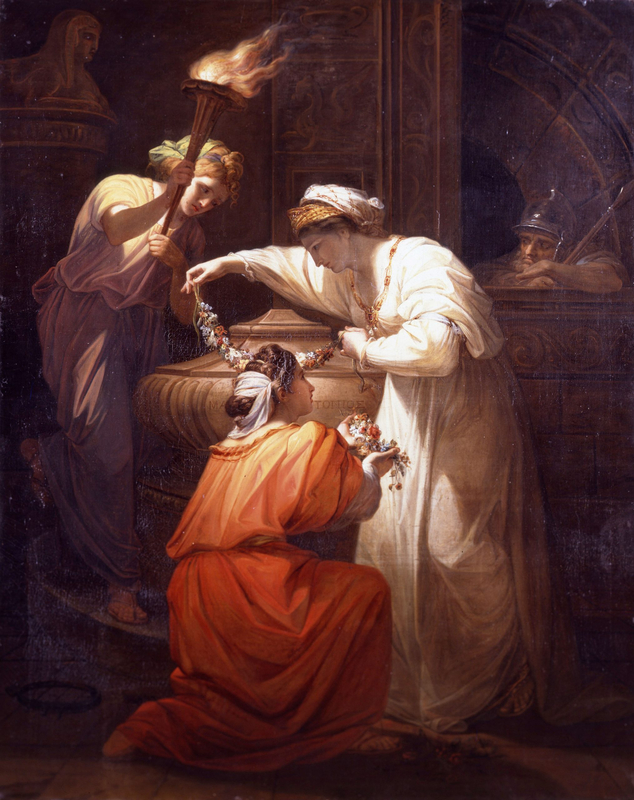
In Agrippina Mourning over the Ashes of Germanicus, 1793, she once again manages to turn a historical episode into a timeless icon of conjugal loyalty and sorrow. Agrippina’s austere Greek profile is a nod to Winckelmann and the Neoclassical ideal of beauty.
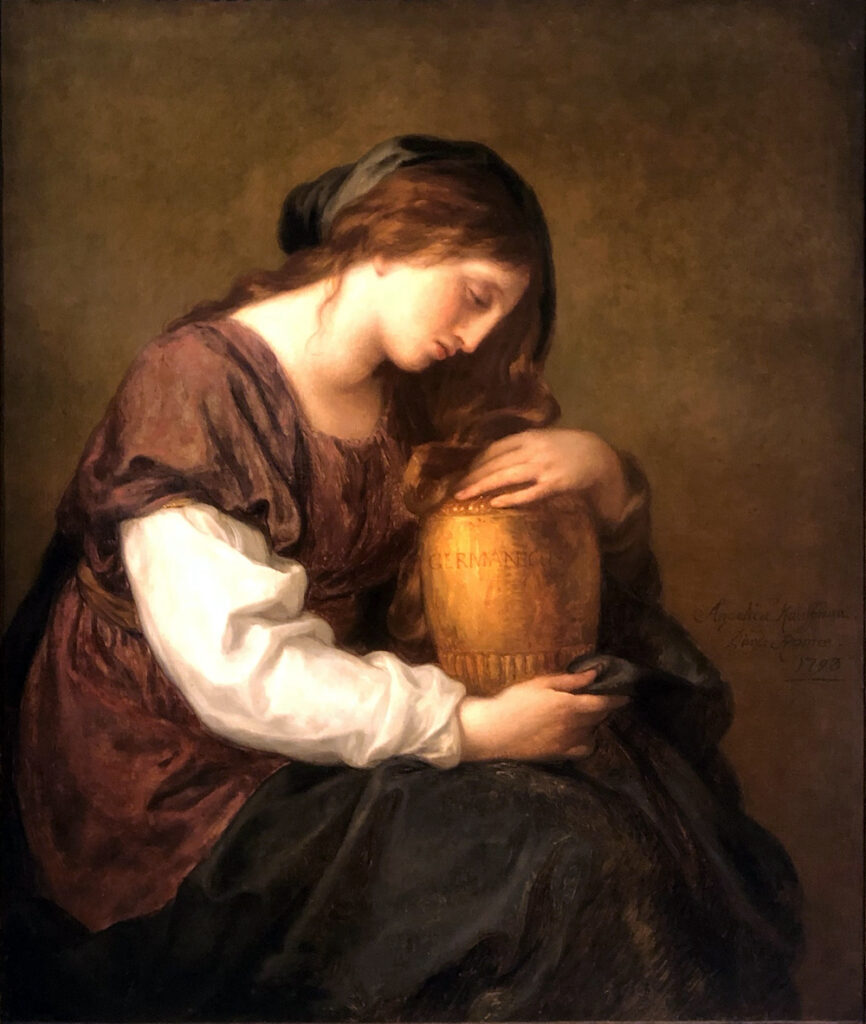
The focus on the lonely female heroine absorbed in her sorrow or mourning characterises Kauffman’s intimate historical scenes, which would prove incredibly successful with collectors. Moreover, through works such as these, she helped shape the sub-genre of the single figure history painting, capable of transcending time through its intense concentration on feeling.
Conclusion: A Sisterhood of Inspired and Inspirational Women
A fulgent example of her depictions of illustrious contemporaries, and one of my favourite paintings by Kauffman, is the Portrait of the Impromptu Virtuoso Fortunata Sulgher Fantastici as Muse. Here, she pays tributed to a fellow artist and friend: the multi-talented poetess who performed twice at Kauffman’s Roman salon, to great acclaim. The work can also be read as a manifesto of her approach to artistic inspiration, and should be considered in tandem with her self-portraits.
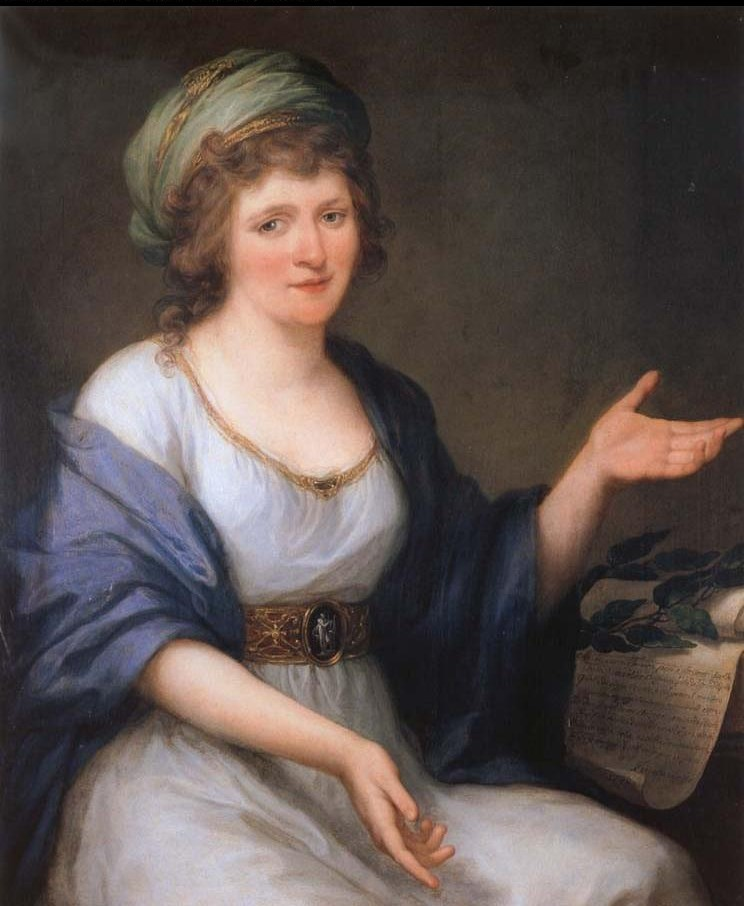
The sitter’s eloquent pose alludes to her skills in improvising. So that Kauffman could immortalize her in mid-declamation, Sulgher composed a poem that she recited during the sittings. She later gifted the composition to Kauffman in return for her portrait. This was but one expression of mutual appreciation and support between the two women. Indeed, Kauffman cultivated several such friendships in both London and Rome, forming bonds that are commemorated in several of her paintings.
By dressing her sitters and heroines in all’antica garb and emphasising their femininity and grace, Kauffman was pointing to their outer beauty in order to bring to the fore their inner virtues.
Any criticism of Kauffman’s work as sentimental and estheticized fails to fully appreciate the novelty of her portrayals of exemplary women past and present. Their beauty signifies the nobility of their character, their strength inextricably bound to their vulnerability.
Dr. Anita Viola Sganzerla has an MA and PhD in Art History from The Courtauld Institute of Art. She is curator of a London-based private collection and co-curated with Deanna Petherbridge the drawings exhibition Artists at Work (The Courtauld Gallery, 3 May–15 July 2018). Follow her on Twitter: @AnitaSganzerla
Visit Art Herstory’s Angelica Kauffman resource page, here.
More Art Herstory blog posts about 18th-century women artists:
Angelica Kauffman: Art, Music and Poetry, by Ellice Wu
Exhibiting Women: The Art of Professionalism in London and Paris, 1760–1830, by Paris Spies-Gans
Mary Linwood’s Balancing Act, by Heidi A. Strobel
Anna Dorothea Therbusch: A Woman Painting Against Eighteenth-century Odds, by Stephanie Pearson
Marie-Thérèse Reboul Vien: Finding the Natural in the Neoclassical, by Tori Champion
Rosalba Carriera at The Frick Collection, by Xavier F. Salomon
Adélaïde Labille-Guiard: Artist, Friend, Teacher, Guest post by Jessica L. Fripp
“I feel again the violence of a curious desire”: Rare client testimonies on Rosalba Carriera’s erotic art, Guest post by Angela Oberer
Angelica Kauffman and Mary Moser: Founding Women Artists of the Royal Academy
Seductive Surfaces: Anne Vallayer-Coster’s Vase of Flowers and Conch Shell at the Met, by Kelsey Brosnan
Marie-Guillemine Benoist, Revolutionary Painter, by Paris Spies-Gans
Rediscovering the Once Visible: Eighteenth-Century Florentine Artist Violante Ferroni, by Ann Golob
More Art Herstory blog posts about self-portraiture by women artists:
Paper Portraits: The Self-Fashioning of Esther Inglis, by Dr. Georgianna Ziegler
Drawings by Bolognese Women Artists at Christ Church, Oxford, by Jacqueline Thalmann
Renaissance Women Painting Themselves, Guest post by Dr. Katherine McIver
Lavinia Fontana and Elisabetta Sirani at the Smith College Art Museum, by Dr. Danielle Carrabino
More blog posts about women artists working in England:
Finding Catherine Read, by Adam Busciakiewicz
Susannah Penelope Rosse: Painting for Pleasure in Seventeenth-Century England, by Anna Pratley
Mary Beale (1633–1699) and the Hubris of Transcription, by Dr. Helen Draper
“Black-works, white-works, colours all”: Finding Susanna Perwich in her Seventeenth-Century Embroidered Cabinet, by Isabella Rosner
Levina Teerlinc, Illuminator at the Tudor Court, by Louisa Woodville
Susanna Horenbout, Courtier and Artist, by Dr. Kathleen E. Kennedy
“Bright Souls”: A London Exhibition Celebrating Mary Beale, Joan Carlile, and Anne Killigrew, by Dr. Laura Gowing



